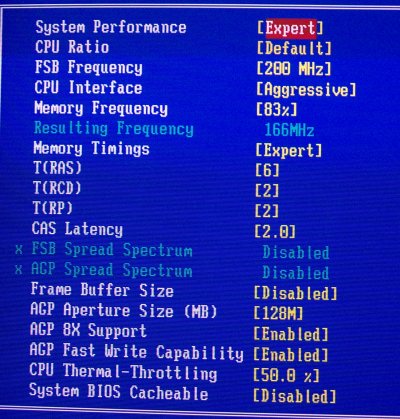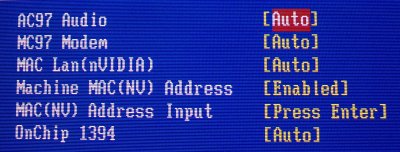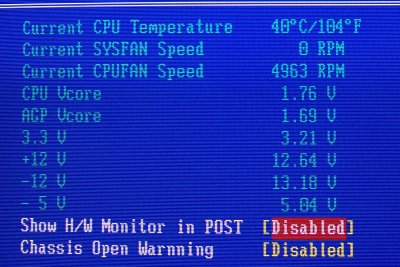M7NCG 400 BIOS
nForce2-based boards have traditionally had excellent BIOSes.
Voltage-wise, the M7NCG 400 is pretty decent. CPU voltage goes from a low 1.3v up to a CPU-frying 2v. We'd suggest caution at anything over 1.85v, though. AGP voltage seems to be a redundant feature currently, yet many manufacturers insist on keeping it in. 1.5v - 1.8v is your choice. DRAM voltage sees a healthy 2.8v, that's about the minimum we would now expect from any decent board. Certain RAM is guaranteed to 3v and beyond, all in the name of performance. The IGP regulator is self-explanatory. It regulates the amount of voltage passed on to the North Bridge. Handy for gaining stability at non-guaranteed speeds.

This lengthy shot details a mass of information. The board had no trouble in assigning chosen multipliers to Barton-based CPUs, which will please the enthusiast. It's also guaranteed to run the latest XP3200 CPU. That requires a default 200MHz FSB, so FSB frequencies range from 100MHz to an improbable 250MHz. You'll note that a memory frequency percentage of 83 is inputted. That's per spec. The board does not guarantee DDR400 speeds with or without onboard graphics. We did manage to get it working at DDR400 with discrete graphics. There was no go with the integrated GeForce4 MX.
Memory latencies provide the usual degree of flexibility. We choose the regular 2-6-2-2 set. Onboard graphics are allocated a fixed amount of system RAM - choices range up to 128MB. Unlike Intel's onboard graphics, the IGP cannot dynamically allocate RAM and call it back when not in use. We'd take the NF2 IGP over the i865G, in graphics terms, every day of the week.

Most of the features emanate from the South Bridge. This, too, seems to be a generic BIOS. We say that because there's no provision for FireWire on the M7NCG 400. It's available as an optional extra on a different model, so that's why it's implanted into this BIOS.

The voltage monitoring section is quite poor by other manufacturer's standards. We've been spoilt lately. We now expect expert fan control and voltage information for every conceivable line. The BIOS is reasonable for a system integrator but falls short of what we'd like as enthusiasts. The CPU voltage, according to BIOS, was a notch above what was manually set, so there's plenty to play with.









